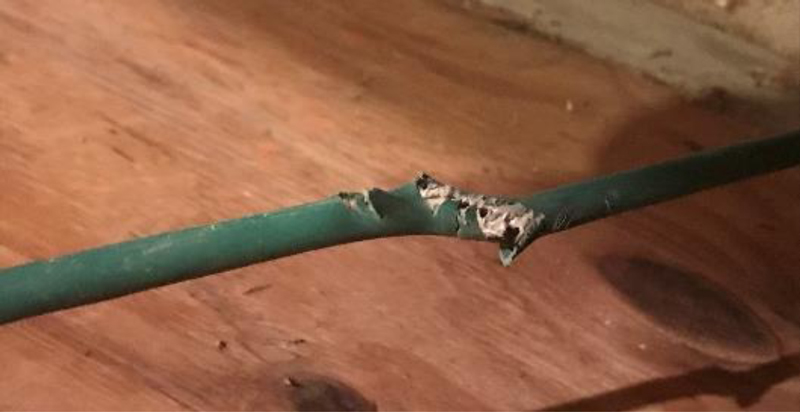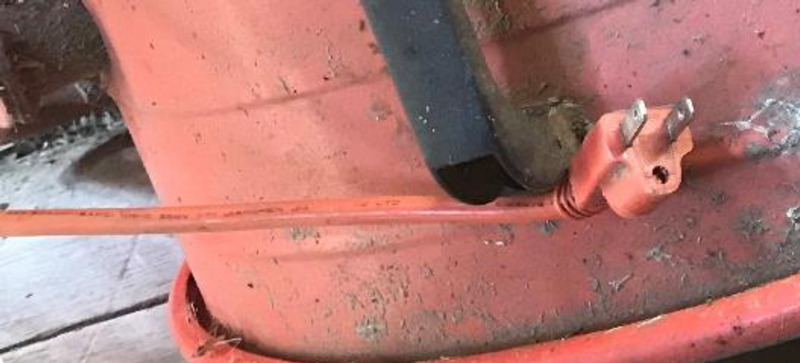The kitchen serves as a central hub of activity where appliances streamline tasks. However, the combination of electricity and water may pose safety risks.
From that vintage mixer inherited from grandma to your brand-new dishwasher, electrical hazards can lurk. Understanding the warning signs empowers you to act BEFORE a small problem becomes a dangerous one.
Click here for a guide to kitchen appliances from The Department of Energy.
Frayed Cords: A Disaster Waiting to Happen
Appliance cords might seem simple, but they’re carrying electricity – and a damaged cord is a serious safety hazard.
The areas where the cord bends are the most vulnerable because the wires inside get flexed repeatedly. Over time, this can lead to cracks, insulation breakdown, and exposed wires.
That’s why it’s crucial to inspect cords regularly, paying close attention to where they enter the appliance and near the plug.

- The #1 Culprit: Examine every appliance cord where it bends near the plug and enters the appliance. Cracks, exposed wires, or worn insulation are all red flags.
- Avoid DIY: Electrical tape is not a solution! Damaged cords should be replaced by a qualified technician due to the high risk of shock or fire.
- Older Appliances: Cords from decades ago weren’t designed for today’s electrical loads. Even if they appear “okay,” aging can make them susceptible to failure.
Shorts & Sparks: Signs Your Appliance Needs Help
Although the aim is to have a kitchen running smoothly, appliances may occasionally indicate underlying issues. Pay attention to these warning signs because electrical issues can escalate quickly.
Here are some crucial red flags that mean an appliance needs professional attention ASAP:
- Sparking = Trouble: If you see sparks when plugging in, unplugging, or while an appliance is running, unplug immediately and don’t use it again until it’s been professionally checked.
- The Burning Smell: Acrid, electrical-type odors, even subtle, mean something is overheating. Unplug and have the appliance inspected.
- Buzzing or humming: Household appliances should not produce excessive noise. Unusual sounds may signal motor issues or loose electrical connections, both of which could pose a safety risk.
Click here for information from Oregon OSHA regarding safe practices for electrical cords.
Tripped Breakers: A Warning System
Don’t underestimate the power of your home’s electrical system to warn you about trouble brewing.
Two significant red flags are often overlooked:
- Appliances that make odd noises
- A breaker that keeps tripping when a specific appliance is used
Here’s why you should take heed:
- Breakers Protect You: When a breaker repeatedly trips with an appliance plugged in, it’s not the breaker being fussy! It is doing its job to prevent a fire or electrical shock.
- Capacity Issues: Older homes may not have enough electrical power to handle modern kitchens full of gadgets. A tripping breaker when multiple appliances run might mean an overall upgrade is needed for safety.
- GFCI Outlets: These are the ones with “test/reset” buttons located near sinks, which are crucial for safety. If one trips while an appliance is plugged in, consider the appliance as the likely cause, not the outlet.

While a home inspection isn’t the same as having an electrician do a full diagnostic on your kitchen, with Eyewitness Home Inspection, I’m trained to spot red flags that pose risks.
Here’s what’s within my scope for kitchen electrical:
- The Obvious Hazards: Damaged cords, scorched outlets, or signs of overheating (discoloration, melted plastic) on an appliance are all causes for concern.
- Water & Electricity Don’t Mix: Outlets near the sink must be GFCI protected for safety. If they’re not, that’s a deficiency that needs immediate attention.
- Signs of Overloaded Circuits: I’ll note if the electrical panel is outdated, if the kitchen is on too few circuits, or if there are signs the overall electrical system is struggling to keep up with demand. This can manifest as flickering lights, dimming when appliances turn on, etc.
- Limits of the Inspection: I can’t open up appliances to examine internal wiring or diagnose specific motor failures. If I see any warning signs, I’ll recommend further evaluation by a qualified electrician.
Remember, a home inspection is designed to give you a snapshot of the property’s condition. My findings inform you about potential electrical safety concerns so you can correct them for both the protection of your family and the long-term health of your home.
Key Takeaway
Kitchen appliances make our lives easier, but it’s crucial to remember that they use powerful electricity. Being proactive and prioritizing safety can avoid preventable accidents.
Here’s your action plan:
- Cord Check Routine: Make it a habit to inspect appliance cords frequently. Look for damage, especially where they bend, and replace any questionable cords immediately.
- Don’t Ignore the Warnings: Indications of sparks, unfamiliar noises, or burning odors suggest that an appliance requires professional maintenance. Disconnect the device and refrain from using it until it has been inspected.
- Heed the Breakers & GFCIs: They are your home’s electrical safety net. If a circuit trips repeatedly, or a GFCI pops when an appliance is plugged in, it’s a sign of trouble and you need to contact an electrician.
- Upgrade If Needed: Older homes sometimes struggle to meet modern electrical demands. If your kitchen seems to cause frequent problems, an electrical panel or circuit upgrade might be necessary for safety.
Empowering yourself with knowledge about kitchen electrical safety is the best way to protect your family and your home!

